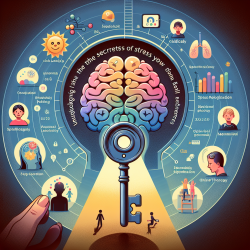As a practitioner working with individuals affected by Parkinson's Disease (PD), understanding the cognitive challenges faced by patients is crucial. Recent research titled "Cognitive Symptoms in Cross-Sectional Parkinson Disease Cohort Evaluated by Human-in-the-Loop Machine Learning and Natural Language Processing" provides valuable insights into these challenges. This study uses advanced technologies like machine learning and natural language processing to analyze patient-reported cognitive symptoms, offering a new perspective on managing PD.
The Role of Technology in Understanding Cognitive Symptoms
The study involved over 25,000 participants who reported their most bothersome cognitive symptoms through the Fox Insight study. By employing human-in-the-loop curation and machine learning algorithms, researchers categorized these symptoms into eight domains: memory, concentration/attention, cognitive slowing, language/word finding, mental alertness/awareness, visuospatial abilities, executive abilities/working memory, and cognitive impairment not otherwise specified.
This approach allows for a detailed examination of cognitive symptoms as experienced by patients themselves. Practitioners can leverage these findings to better understand the subjective experiences of their patients and tailor their therapeutic approaches accordingly.
Implications for Practitioners
The study highlights several key findings that practitioners can use to enhance their skills:
- Prevalence of Cognitive Symptoms: Nearly one-third of participants reported cognitive symptoms as among their most bothersome problems. Memory issues were the most frequently reported symptom.
- Impact of Depression: Depression was significantly associated with cognitive problems across all domains except visuospatial abilities. This underscores the importance of addressing mental health alongside cognitive therapy.
- Age and Education Influence: The odds of reporting posterior cortical symptoms increased with age and higher education levels. This suggests that practitioners should consider demographic factors when assessing and planning treatment.
Encouraging Further Research
This research opens up numerous avenues for further exploration. Practitioners are encouraged to delve deeper into the integration of technology in understanding cognitive impairments. By staying informed about advancements in machine learning and natural language processing, therapists can enhance their practice and provide more effective interventions.
Moreover, the study emphasizes the need for both subjective cognitive concerns and objective assessments to be part of clinical evaluations. This dual approach can help identify early signs of cognitive decline and improve patient outcomes.
Conclusion
The integration of human-in-the-loop machine learning and natural language processing provides a powerful tool for understanding cognitive symptoms in Parkinson's Disease. By applying these insights, practitioners can improve their therapeutic strategies and better support their patients. For those interested in exploring this research further, it is recommended to read the original paper for a comprehensive understanding.
To read the original research paper, please follow this link: Cognitive Symptoms in Cross-Sectional Parkinson Disease Cohort Evaluated by Human-in-the-Loop Machine Learning and Natural Language Processing.










